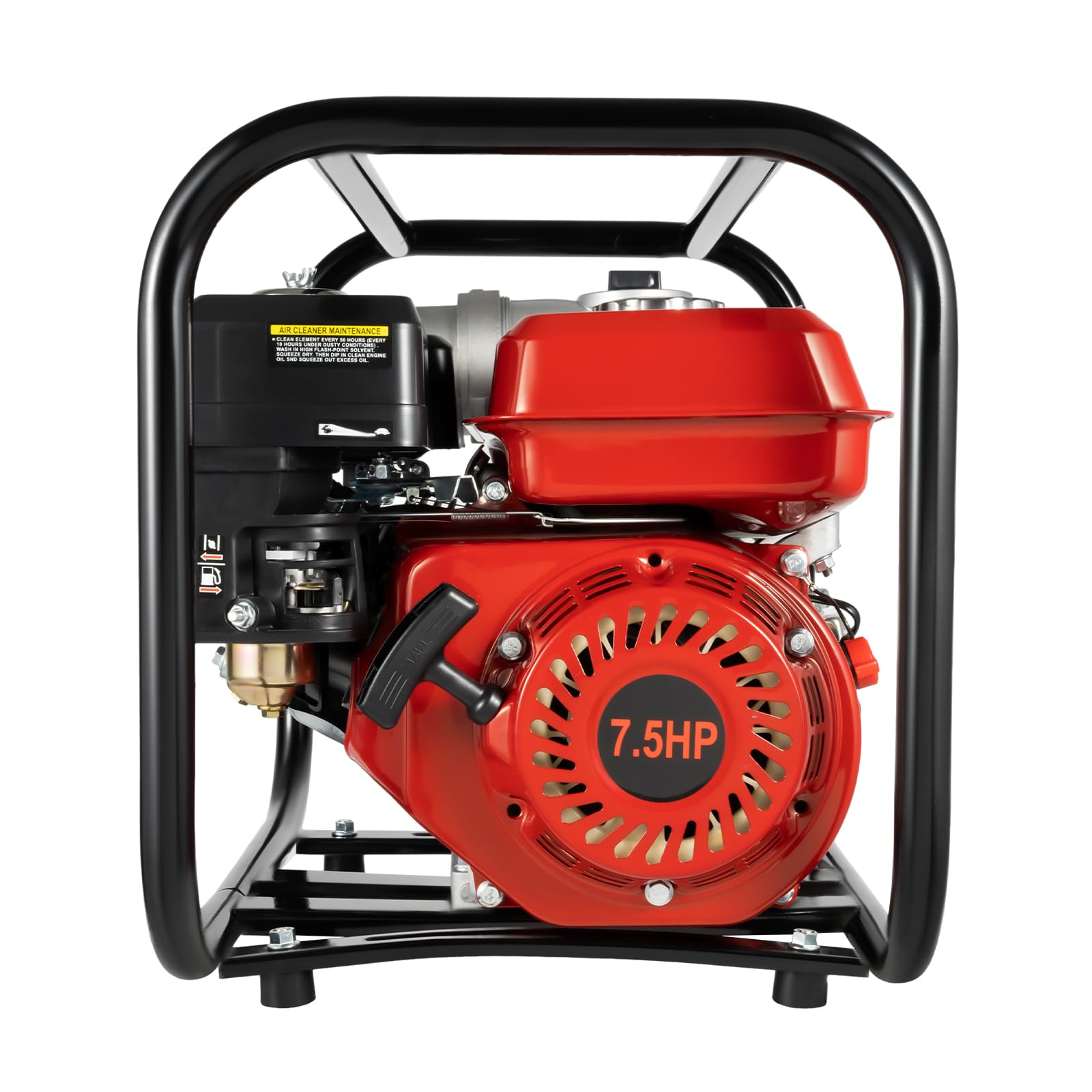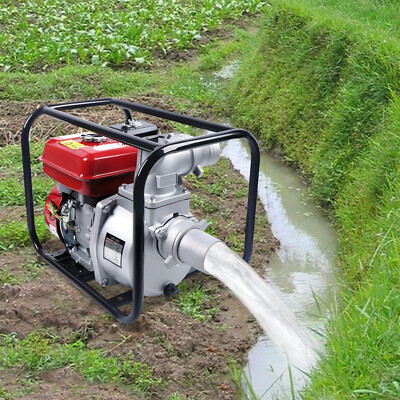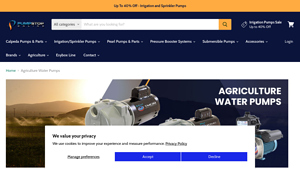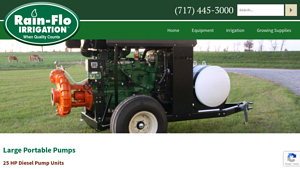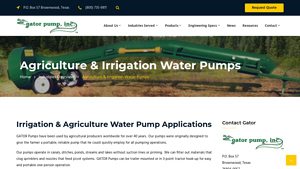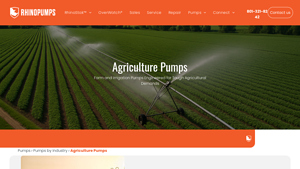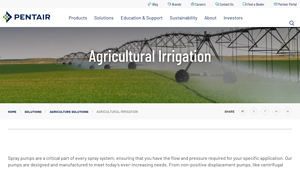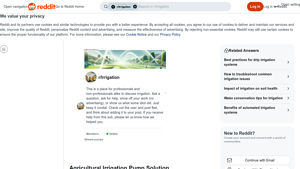Introduction: Navigating the Global Market for agricultural irrigation water pump
In the rapidly evolving landscape of global agriculture, sourcing the right agricultural irrigation water pump is a pivotal challenge for B2B buyers. With increasing pressure to optimize water usage and enhance crop yields, selecting the appropriate pump can significantly impact operational efficiency and sustainability. This comprehensive guide delves into the diverse types of irrigation pumps available on the market, their specific applications, and essential factors to consider when making a purchase.
From centrifugal and submersible pumps to portable solutions designed for various terrains, understanding the nuances of each type is crucial for maximizing irrigation effectiveness. Additionally, the guide will cover supplier vetting processes, ensuring that buyers can identify trustworthy manufacturers and distributors, as well as provide insights into cost considerations, helping businesses manage budgets without compromising quality.
By equipping international B2B buyers—particularly those in regions like Africa, South America, the Middle East, and Europe (including key markets such as Nigeria and Germany)—with actionable knowledge, this guide empowers informed purchasing decisions. Whether you’re aiming to enhance existing irrigation systems or embarking on new agricultural projects, navigating the complexities of pump selection will become a streamlined process, ultimately contributing to sustainable agricultural practices and improved productivity.
Understanding agricultural irrigation water pump Types and Variations
| Type Name | Key Distinguishing Features | Primary B2B Applications | Brief Pros & Cons for Buyers |
|---|---|---|---|
| Centrifugal Pumps | Utilize rotational energy to move water; available in single and multi-stage designs. | Flood and furrow irrigation, water transfer. | Pros: High flow rates, efficient for large volumes. Cons: Less effective at high pressures; may require priming. |
| Submersible Pumps | Designed to be submerged in water; efficient for deep well applications. | Deep well irrigation, groundwater extraction. | Pros: High efficiency, minimal noise. Cons: More complex installation; can be costly to maintain. |
| Diaphragm Pumps | Use a diaphragm to create suction; ideal for handling viscous fluids. | Fertilizer and chemical injection, irrigation. | Pros: Handles solids and chemicals, low maintenance. Cons: Lower flow rates compared to centrifugal pumps. |
| Portable Pumps | Mobile units, often diesel-powered; designed for quick deployment. | Emergency irrigation, temporary water supply. | Pros: Versatile and easy to transport. Cons: Limited capacity; may not be suitable for long-term use. |
| Booster Pumps | Increase pressure in existing irrigation systems; often used with sprinklers. | Pressure boosting in irrigation systems. | Pros: Enhances system performance, efficient. Cons: Requires proper sizing; may need regular maintenance. |
What Are the Key Characteristics of Centrifugal Pumps in Agriculture?
Centrifugal pumps are widely favored in agricultural irrigation due to their ability to move large volumes of water efficiently. They are available in both single-stage and multi-stage configurations, allowing for flexibility depending on the application. These pumps excel in flood and furrow irrigation systems where high flow rates are essential. When purchasing, buyers should consider the pump’s compatibility with their existing systems and the total dynamic head required for their specific irrigation needs.
How Do Submersible Pumps Benefit Deep Well Irrigation?
Submersible pumps are specifically designed to operate underwater, making them ideal for deep well irrigation and groundwater extraction. Their design allows for efficient water movement from significant depths, which is crucial in regions where surface water is scarce. Buyers should evaluate the pump’s horsepower and flow rate to ensure it meets their operational demands, keeping in mind the potential higher installation costs associated with submersible systems.
In What Situations Are Diaphragm Pumps Most Effective?
Diaphragm pumps are particularly effective for applications that require the handling of viscous fluids or those containing solids, such as fertilizers and chemicals. Their mechanism allows for precise dosing and minimal backflow, making them suitable for injection applications in irrigation systems. When considering diaphragm pumps, B2B buyers should assess the chemical compatibility and flow rate requirements to ensure optimal performance.
Why Choose Portable Pumps for Temporary Irrigation Solutions?
Portable pumps are designed for mobility, allowing agricultural operations to quickly adapt to changing water needs, especially in emergency situations. These diesel-powered units can be easily transported and set up, providing a temporary water supply for irrigation. However, buyers should be aware of their limitations in capacity and consider the frequency of use to determine whether a portable solution meets their long-term needs.
How Do Booster Pumps Enhance Irrigation System Performance?
Booster pumps play a crucial role in increasing water pressure within existing irrigation systems, particularly those utilizing sprinklers. They are essential for ensuring that water reaches all areas of a field efficiently, especially in larger operations. When selecting a booster pump, buyers should focus on the system’s pressure requirements and the pump’s compatibility with other irrigation components to maximize effectiveness.
Key Industrial Applications of agricultural irrigation water pump
| Industry/Sector | Specific Application of Agricultural Irrigation Water Pump | Value/Benefit for the Business | Key Sourcing Considerations for this Application |
|---|---|---|---|
| Crop Production | Flood and furrow irrigation for row crops | Maximizes water efficiency, ensuring optimal crop yield | Flow rate compatibility, energy efficiency, and portability |
| Aquaculture | Water management in fish farms (e.g., catfish, shrimp) | Supports healthy aquatic life and optimizes growth rates | Durability in harsh environments, filtration capabilities, and size |
| Dairy and Livestock Farming | Waste management and nutrient distribution | Enhances farm hygiene, reducing disease risk | Pump capacity, compatibility with existing systems, and maintenance |
| Horticulture and Greenhouses | Drip irrigation systems for high-value crops | Increases water conservation and crop quality | Precision in flow control, pressure requirements, and adaptability |
| Land Reclamation and Dredging | Dredging water intakes for irrigation and aquaculture | Ensures sustainable water supply for agricultural use | Pump mobility, suction capabilities, and resistance to clogging |
How is Agricultural Irrigation Water Pump Used in Crop Production?
In crop production, agricultural irrigation water pumps are essential for flood and furrow irrigation systems. These pumps efficiently deliver water to fields, maximizing moisture availability crucial for crop growth. By enabling farmers to manage water supply effectively, these pumps help in achieving optimal yields. For international buyers, particularly in regions like Africa and South America, selecting pumps with high flow rates and energy efficiency is vital to ensure they meet the demands of large-scale farming operations.
What Role Does Water Pumping Play in Aquaculture?
In aquaculture, agricultural irrigation water pumps are utilized for managing water quality and circulation in fish farms, such as those raising catfish and shrimp. These pumps facilitate the movement of water, ensuring that oxygen levels remain optimal for aquatic life. Additionally, they help in filtering out debris, which is crucial for maintaining a healthy environment. Buyers in regions like the Middle East should consider pumps that offer durability against corrosive environments and effective filtration features.
How Do Pumps Support Dairy and Livestock Farming?
For dairy and livestock farming, agricultural irrigation water pumps play a critical role in waste management and nutrient distribution. These pumps help in efficiently moving waste materials away from animal housing, thus enhancing hygiene and reducing the risk of disease outbreaks. When sourcing pumps for this application, businesses must focus on capacity and compatibility with existing waste management systems to ensure seamless operations and compliance with agricultural standards.
What Benefits Do Water Pumps Provide in Horticulture and Greenhouses?
In horticulture, particularly in greenhouse settings, agricultural irrigation water pumps are vital for drip irrigation systems. These systems ensure precise water delivery to high-value crops, which is essential for maximizing water conservation and enhancing crop quality. International B2B buyers should prioritize pumps that offer precision flow control and can adapt to varying pressure requirements to optimize irrigation strategies effectively.
How Are Agricultural Irrigation Water Pumps Used in Land Reclamation and Dredging?
Agricultural irrigation water pumps are instrumental in dredging water intakes for irrigation and aquaculture, ensuring a sustainable water supply for agricultural use. These pumps facilitate the removal of sediment and debris, enhancing water flow into irrigation systems. For businesses involved in land reclamation, sourcing pumps that are mobile and have strong suction capabilities is crucial, particularly in regions facing challenges such as flooding or sediment buildup.
3 Common User Pain Points for ‘agricultural irrigation water pump’ & Their Solutions
Scenario 1: Inconsistent Water Supply Disrupts Crop Production
The Problem: In regions heavily reliant on agriculture, such as parts of Africa and South America, a common challenge faced by B2B buyers is the inconsistency of water supply due to varying climatic conditions and seasonal changes. This unpredictability can lead to inadequate irrigation, resulting in reduced crop yields and financial losses. Buyers often struggle to find pumps that can efficiently manage both low and high water levels, leading to uncertainty in agricultural planning and execution.
The Solution: To address this issue, B2B buyers should consider investing in variable speed pumps or multi-stage centrifugal pumps that can adapt to fluctuating water levels. These pumps allow for precise control of water flow, enabling farmers to tailor irrigation to their specific needs. Additionally, implementing an automated irrigation system that integrates with weather forecasts can optimize water use, ensuring crops receive adequate moisture. Buyers should also seek suppliers that offer robust support and maintenance services, ensuring their systems remain operational even during peak demand periods.
Scenario 2: High Operational Costs Due to Inefficient Equipment
The Problem: Many agricultural enterprises face escalating operational costs due to outdated or inefficient irrigation pumps. This is particularly true in regions where energy costs are high, such as parts of Europe and the Middle East. Inefficient pumps not only consume more energy but also require frequent repairs, further draining financial resources. B2B buyers often find it challenging to justify the upfront investment in new equipment when faced with tight budgets.
The Solution: B2B buyers should prioritize energy-efficient pumps that offer lower operational costs over time. Investing in high-efficiency models, such as those with premium efficiency motors and advanced hydraulic designs, can significantly reduce energy consumption. Furthermore, conducting a cost-benefit analysis that compares the long-term savings from efficiency gains against the initial investment can help in making informed decisions. Collaborating with manufacturers who provide energy audits can also yield insights into optimizing existing systems and identifying potential upgrades that offer the best return on investment.
Scenario 3: Clogging and Maintenance Issues Impacting Productivity
The Problem: Clogging is a frequent issue with agricultural irrigation pumps, particularly when sourcing water from natural bodies such as rivers and lakes. Debris and sediment can easily clog filters and nozzles, leading to equipment downtime and reduced irrigation efficiency. This is a significant concern for agricultural buyers who require continuous and reliable water flow to maintain crop health. The consequences of neglecting maintenance can be dire, resulting in lost revenue and damaged crops.
The Solution: To combat clogging, B2B buyers should invest in pumps designed with self-cleaning features or pre-filters that effectively remove debris before it enters the system. Additionally, establishing a regular maintenance schedule can prevent minor issues from escalating into major problems. Buyers can also consider training staff on best practices for pump operation and maintenance, ensuring that they are aware of the common signs of clogging and can respond swiftly. Partnering with suppliers that offer comprehensive support, including quick access to replacement parts and service technicians, can further minimize downtime and maintain productivity.
Strategic Material Selection Guide for agricultural irrigation water pump
What Are the Key Materials Used in Agricultural Irrigation Water Pumps?
When selecting agricultural irrigation water pumps, the choice of materials is crucial for ensuring optimal performance, longevity, and compatibility with various water sources. Below are analyses of four common materials used in the manufacturing of these pumps, focusing on their properties, advantages, disadvantages, and considerations for international buyers.
How Does Stainless Steel Perform in Agricultural Irrigation Water Pumps?
Key Properties: Stainless steel is renowned for its excellent corrosion resistance, high strength, and ability to withstand elevated temperatures and pressures. It typically has a temperature rating of up to 800°F and can handle pressures exceeding 150 psi, making it suitable for various irrigation applications.
Pros & Cons: The durability of stainless steel ensures a long service life, reducing the need for frequent replacements. However, it is more expensive than other materials like plastic or cast iron, which may deter budget-conscious buyers. Manufacturing complexity can also be higher due to the need for specialized welding techniques.
Impact on Application: Stainless steel is compatible with a wide range of media, including freshwater, saline water, and chemical solutions. Its non-reactive nature makes it ideal for applications where water quality is a concern, such as in organic farming.
Considerations for International Buyers: Buyers from regions like Europe and Germany may prefer stainless steel pumps due to stringent compliance standards (e.g., DIN) regarding materials used in agricultural applications. In contrast, buyers in Africa and South America may weigh the cost-benefit ratio more heavily.
What Role Does Cast Iron Play in Agricultural Irrigation Water Pumps?
Key Properties: Cast iron is known for its high strength and excellent wear resistance. It typically operates well within a temperature range of -20°F to 300°F and can handle moderate pressures, making it suitable for many irrigation tasks.
Pros & Cons: While cast iron is durable and relatively inexpensive, it is prone to corrosion when exposed to moisture and certain chemicals. This can lead to increased maintenance costs over time. Additionally, its weight can make installation and transportation more challenging.
Impact on Application: Cast iron pumps are often used in applications where high flow rates are required, such as flood irrigation. However, they may not be suitable for saline or corrosive environments, which could limit their use in certain regions.
Considerations for International Buyers: Buyers in the Middle East might need to consider the impact of high salinity in water sources, which can corrode cast iron. Compliance with local standards (e.g., ASTM) should also be taken into account.
How Effective Are Plastic Materials in Agricultural Irrigation Water Pumps?
Key Properties: Plastic materials, such as PVC and polyethylene, are lightweight and resistant to corrosion and chemicals. They typically operate effectively within a temperature range of 32°F to 140°F and can handle low to moderate pressures.
Pros & Cons: The primary advantage of plastic pumps is their low cost and ease of installation. However, they may not be as durable as metal options and can degrade under UV exposure or extreme temperatures, limiting their longevity.
Impact on Application: Plastic pumps are ideal for small-scale irrigation systems and applications where water quality is not critical. They are often used in drip irrigation systems and can handle freshwater efficiently.
Considerations for International Buyers: Buyers in regions with high UV exposure, such as Africa, should consider UV-resistant options. Compliance with international standards for food safety may also be a concern for agricultural applications.
What Advantages Do Bronze Materials Offer in Agricultural Irrigation Water Pumps?
Key Properties: Bronze exhibits excellent corrosion resistance, particularly against seawater and other corrosive environments. It can handle temperatures up to 400°F and moderate pressures, making it suitable for various irrigation applications.
Pros & Cons: Bronze pumps are durable and have a long lifespan, but they are generally more expensive than cast iron and plastic options. Manufacturing can be complex due to the alloying process, which may add to production costs.
Impact on Application: Bronze is particularly effective in applications involving saline water or where chemical exposure is a concern. Its corrosion resistance makes it suitable for coastal agricultural operations.
Considerations for International Buyers: Buyers in coastal regions, such as parts of South America and the Middle East, may find bronze pumps particularly advantageous. Compliance with local standards, such as JIS, should be considered when making a selection.
Summary Table of Material Selection for Agricultural Irrigation Water Pumps
| Material | Typical Use Case for agricultural irrigation water pump | Key Advantage | Key Disadvantage/Limitation | Relative Cost (Low/Med/High) |
|---|---|---|---|---|
| Stainless Steel | High-quality, chemical-sensitive applications | Excellent corrosion resistance | Higher cost and manufacturing complexity | High |
| Cast Iron | Flood irrigation, high flow rate applications | Durable and cost-effective | Prone to corrosion in moist environments | Med |
| Plastic | Small-scale, low-cost irrigation systems | Lightweight and easy to install | Less durable, UV degradation risk | Low |
| Bronze | Saline water applications, coastal farming | Exceptional corrosion resistance | Higher cost and complex manufacturing | High |
This guide provides actionable insights for B2B buyers to make informed decisions on material selection for agricultural irrigation water pumps, taking into account various operational needs and regional considerations.
In-depth Look: Manufacturing Processes and Quality Assurance for agricultural irrigation water pump
What Are the Key Manufacturing Processes for Agricultural Irrigation Water Pumps?
The manufacturing of agricultural irrigation water pumps involves several critical stages that ensure the final product meets the rigorous demands of the agricultural sector. Understanding these processes can help B2B buyers identify quality products that suit their needs.
What Are the Main Stages of Manufacturing Agricultural Irrigation Water Pumps?
Material Preparation
The first step in manufacturing involves sourcing high-quality raw materials. Common materials include stainless steel, cast iron, and bronze, each chosen for their durability and resistance to corrosion. Suppliers often conduct material tests to ensure they meet specific mechanical and chemical properties. This stage also involves cutting and shaping the materials into manageable sizes for the forming process.Forming Techniques
The forming stage includes various techniques such as casting, forging, and machining.
– Casting is frequently used for creating pump housings and impellers. It allows for complex shapes and reduces the need for extensive machining.
– Forging is often employed for components requiring high strength, like shafts.
– Machining is utilized to achieve precise tolerances on components, ensuring that parts fit together seamlessly. The choice of technique impacts both the performance and cost of the pump.Assembly Process
Once the components are formed, they undergo assembly. This stage may involve manual labor or automated systems, depending on the scale of production. Key components, including motors, seals, and impellers, are assembled in a clean environment to minimize contamination. Proper alignment and fit are crucial to avoid operational issues later.Finishing Touches
After assembly, pumps go through finishing processes such as surface treatment, painting, or coating. These treatments enhance the pump’s resistance to environmental factors, extending its lifespan. Finishing also includes quality checks to ensure that visual and physical characteristics meet the required standards.
How Is Quality Assurance Implemented in the Manufacturing of Water Pumps?
Quality assurance (QA) is critical in the manufacturing process to ensure that pumps function reliably under demanding agricultural conditions. B2B buyers should be aware of the QA processes to verify product quality before procurement.
What International Standards Are Relevant for Quality Control in Pump Manufacturing?
ISO 9001
This international standard sets the criteria for a quality management system (QMS). Manufacturers must demonstrate their ability to consistently provide products that meet customer and regulatory requirements. Adherence to ISO 9001 indicates a commitment to quality and continuous improvement.CE Marking
For manufacturers targeting the European market, CE marking signifies compliance with EU safety, health, and environmental protection standards. This certification is crucial for ensuring that pumps are safe to operate and environmentally friendly.API Standards
The American Petroleum Institute (API) offers specific standards for equipment used in the oil and gas sector, which can be relevant for pumps used in agricultural irrigation applications that involve chemical handling or other hazardous materials.
What Are the Key Quality Control Checkpoints in Pump Manufacturing?
Quality control (QC) checkpoints help ensure that every pump produced meets the required specifications. Key checkpoints include:
Incoming Quality Control (IQC)
This initial checkpoint assesses raw materials before they enter the manufacturing process. IQC involves material inspections and testing to verify compliance with specifications.In-Process Quality Control (IPQC)
During manufacturing, IPQC focuses on monitoring the production process. Techniques such as statistical process control (SPC) are often used to identify variations and implement corrective actions promptly.Final Quality Control (FQC)
After assembly, pumps undergo FQC, where comprehensive tests are performed to assess performance metrics such as flow rate, pressure, and energy efficiency. This step is crucial for ensuring that the pump meets operational standards before shipment.
How Can B2B Buyers Verify Supplier Quality Control Practices?
B2B buyers, particularly in regions like Africa, South America, the Middle East, and Europe, should take proactive steps to verify the quality control practices of suppliers.
Supplier Audits
Conducting on-site audits allows buyers to evaluate the manufacturing processes, quality control measures, and compliance with international standards. This firsthand experience can significantly influence purchasing decisions.Requesting Quality Reports
Buyers should request documentation detailing the QC processes, including test results and certifications. This information provides insights into the reliability and performance of the pumps.Third-Party Inspections
Engaging third-party inspection services can offer an unbiased assessment of the products. These organizations often conduct rigorous testing and quality checks, providing buyers with an additional layer of confidence in their purchase.
What Unique Quality Control Considerations Exist for International B2B Buyers?
When sourcing agricultural irrigation pumps internationally, buyers must navigate various quality control nuances:
Regulatory Compliance
Different regions have specific regulatory requirements. Understanding these can help buyers avoid compliance issues. For instance, European buyers must ensure that products meet CE marking requirements, while buyers in Africa may focus on local standards.Cultural and Communication Barriers
Establishing clear communication channels with suppliers is vital. Cultural differences can impact negotiations and expectations around quality. Buyers should ensure that specifications are clearly defined and understood.Logistics and Supply Chain Considerations
The distance between suppliers and buyers can affect product quality during transport. Buyers should consider logistics solutions that minimize delays and ensure that pumps arrive in optimal condition.
In conclusion, understanding the manufacturing processes and quality assurance measures for agricultural irrigation water pumps is essential for B2B buyers. By focusing on supplier quality control, compliance with international standards, and effective verification methods, buyers can make informed decisions that support their agricultural needs.
Practical Sourcing Guide: A Step-by-Step Checklist for ‘agricultural irrigation water pump’
Introduction
This guide serves as a comprehensive checklist for B2B buyers seeking to procure agricultural irrigation water pumps. By following these steps, you can ensure that your purchasing decisions are informed, strategic, and aligned with your operational needs, ultimately enhancing your agricultural productivity.
1. Define Your Technical Specifications
Clearly outline the technical requirements for your irrigation water pump. Consider factors such as flow rate, total dynamic head, power requirements, and the type of water source (e.g., river, well, or canal). Knowing your specifications helps in narrowing down suitable options that will meet your irrigation needs effectively.
2. Research Available Types of Pumps
Familiarize yourself with the different types of irrigation pumps available in the market, such as centrifugal, submersible, and jet pumps. Each type has distinct advantages depending on your specific application, such as flood irrigation or high-volume water transfer. Understanding these options allows you to choose a pump that best suits your operational context.
3. Evaluate Potential Suppliers
Before making a commitment, thoroughly vet potential suppliers. Request detailed company profiles, references from other agricultural clients, and case studies showcasing their products in action. This due diligence ensures that you partner with reliable suppliers who can meet your quality and service expectations.
4. Verify Supplier Certifications and Compliance
Ensure that your chosen suppliers hold necessary certifications and comply with industry standards relevant to your region. This may include ISO certifications or compliance with local agricultural regulations. Verified certifications not only enhance product reliability but also ensure safety and environmental compliance.
5. Assess After-Sales Support and Warranty Options
Investigate the after-sales support offered by suppliers, including installation assistance, maintenance services, and warranty policies. A strong after-sales support system is crucial for addressing potential issues post-purchase, ensuring your irrigation system runs smoothly with minimal downtime.
6. Request and Compare Quotes
Solicit quotes from multiple suppliers to compare pricing, delivery times, and payment terms. Look beyond the initial cost; consider total cost of ownership, which includes installation, maintenance, and operational expenses. This comprehensive comparison will help you make an economically sound decision.
7. Plan for Logistics and Installation
Consider the logistics involved in transporting and installing the pump. Ensure that the supplier can provide timely delivery and installation services, especially if you are operating in remote areas. Proper planning in this phase can prevent delays and additional costs, ensuring that your irrigation system is operational when needed.
By adhering to this checklist, B2B buyers can navigate the complexities of sourcing agricultural irrigation water pumps with confidence, ensuring that they select the right equipment for their agricultural needs.
Comprehensive Cost and Pricing Analysis for agricultural irrigation water pump Sourcing
What Are the Key Cost Components of Agricultural Irrigation Water Pumps?
When sourcing agricultural irrigation water pumps, understanding the cost structure is essential for effective budgeting and procurement. The primary cost components include:
Materials: The type of materials used, such as stainless steel or cast iron, significantly impacts pricing. High-quality materials enhance durability and efficiency, justifying a higher initial investment.
Labor: Labor costs encompass both direct labor for assembly and indirect labor involved in design and engineering. For manufacturers, labor efficiency can influence final pricing.
Manufacturing Overhead: This includes costs related to factory operations such as utilities, depreciation of equipment, and facility maintenance. These overhead costs are often factored into the final price.
Tooling: Custom tooling for specific pump designs can be a significant upfront cost. Buyers should consider whether the required tooling is already available or if new investments are necessary.
Quality Control (QC): Rigorous QC processes ensure that pumps meet industry standards and certifications, which can add to production costs. However, investing in quality control can reduce long-term failures and maintenance costs.
Logistics: Shipping, handling, and insurance are critical logistics costs that can vary based on the origin of the pumps and delivery location. Buyers should be aware of the potential for increased costs in remote areas.
Margin: Supplier margins can vary widely, influenced by their market positioning and operational efficiencies. Understanding the supplier’s pricing strategy can aid in negotiations.
How Do Price Influencers Affect Agricultural Irrigation Water Pump Costs?
Several factors can influence the pricing of agricultural irrigation water pumps, including:
Volume/MOQ: Bulk purchasing often leads to discounts. Buyers should consider their immediate and future needs to negotiate favorable terms.
Specifications and Customization: Custom-designed pumps tailored to specific agricultural applications typically incur higher costs. Buyers must balance the need for customization with budget constraints.
Materials: The choice of materials not only affects the durability and performance but also the overall cost. High-performance materials can lead to longer lifespans and lower maintenance costs, making them a worthwhile investment.
Quality and Certifications: Pumps that meet international quality standards may come at a premium. However, such certifications can provide assurance regarding reliability and performance.
Supplier Factors: Supplier reputation, reliability, and after-sales support can impact pricing. Established suppliers may charge more but offer better service and warranty options.
Incoterms: Understanding Incoterms is crucial for international buyers. The chosen terms can affect shipping costs and responsibilities, influencing the total cost of acquisition.
What Tips Can Buyers Use to Optimize Costs in Sourcing Agricultural Irrigation Water Pumps?
To achieve cost efficiency when sourcing agricultural irrigation water pumps, consider the following strategies:
Negotiate Terms: Leverage your purchasing power to negotiate better prices, especially for larger orders. Don’t hesitate to request volume discounts or favorable payment terms.
Evaluate Total Cost of Ownership (TCO): Assess not only the upfront costs but also the long-term operational and maintenance costs. A cheaper pump may lead to higher TCO if it requires frequent repairs or has lower efficiency.
Research Local Market Conditions: Understanding the local agricultural market can provide insights into pricing trends. For instance, prices in Nigeria may differ significantly from those in Germany due to supply chain variations.
Seek Multiple Quotes: Obtain quotes from various suppliers to compare prices and terms. This practice can also provide leverage during negotiations.
Consider Logistics Carefully: Factor in shipping and handling costs when evaluating supplier options. Opting for a supplier closer to your operation can minimize logistics costs.
Disclaimer on Indicative Prices
The prices of agricultural irrigation water pumps can vary significantly based on the above factors and the supplier’s pricing strategy. The examples provided, such as centrifugal pumps ranging from approximately $700 to over $14,000, serve only as a reference point. Always request updated quotes and detailed breakdowns to understand the total costs involved in your specific procurement scenario.
Alternatives Analysis: Comparing agricultural irrigation water pump With Other Solutions
Exploring Alternatives to Agricultural Irrigation Water Pumps
When it comes to agricultural irrigation, efficiency and effectiveness are paramount. While agricultural irrigation water pumps are a popular choice for many farmers, exploring alternative solutions can lead to improved outcomes, especially in diverse geographical and economic contexts. This analysis compares agricultural irrigation water pumps with two viable alternatives: Drip Irrigation Systems and Rainwater Harvesting.
Comparison Table
| Comparison Aspect | Agricultural Irrigation Water Pump | Drip Irrigation System | Rainwater Harvesting |
|---|---|---|---|
| Performance | High flow rates, suitable for large areas | Precise water delivery to plant roots | Variable, depends on rainfall and storage capacity |
| Cost | Initial investment varies ($700 – $14,000) | Moderate ($1,000 – $3,000) | Low to moderate (depends on system design) |
| Ease of Implementation | Requires setup and possibly infrastructure upgrades | Needs planning for layout and installation | Requires rain collection system and storage |
| Maintenance | Regular checks, potential repairs needed | Minimal, mainly filter maintenance | Seasonal checks, potential cleaning of tanks |
| Best Use Case | Large-scale operations needing high water volumes | Water-intensive crops in arid regions | Areas with seasonal rain, low-cost irrigation needs |
What Are the Pros and Cons of Drip Irrigation Systems?
Drip irrigation systems are designed for precise water application directly to the root zone of plants. This method is particularly advantageous in regions with limited water supply or where water conservation is essential. The system minimizes water loss due to evaporation and runoff, making it highly efficient. However, the initial setup can be costly and requires careful planning to ensure optimal layout and effectiveness. Maintenance is generally low, but clogged emitters can pose a challenge.
What Are the Advantages and Disadvantages of Rainwater Harvesting?
Rainwater harvesting involves capturing and storing rainwater for irrigation. This method is cost-effective, especially in regions with ample rainfall, and it significantly reduces reliance on groundwater or municipal water sources. The system can be simple, such as using barrels or more complex with larger storage tanks and filtration systems. However, its effectiveness is highly dependent on local climate conditions, and the variable nature of rainfall can lead to inconsistent water supply. Regular maintenance of storage tanks is necessary to ensure water quality.
Conclusion: How Can B2B Buyers Choose the Right Irrigation Solution?
Selecting the right irrigation solution requires a thorough understanding of specific agricultural needs, local climate, and available resources. Agricultural irrigation water pumps are ideal for large-scale operations that demand high water volumes and rapid application. In contrast, drip irrigation systems are better suited for crops that require precise watering, especially in water-scarce regions. Rainwater harvesting offers an eco-friendly and cost-effective alternative where rainfall is plentiful. By evaluating the performance, cost, ease of implementation, and maintenance needs of each option, B2B buyers can make informed decisions tailored to their agricultural practices, ensuring sustainable and efficient irrigation solutions.
Essential Technical Properties and Trade Terminology for agricultural irrigation water pump
What Are the Key Technical Properties of Agricultural Irrigation Water Pumps?
When selecting agricultural irrigation water pumps, understanding critical specifications is essential for making informed purchasing decisions. Here are some of the most important technical properties to consider:
1. Flow Rate (GPH or GPM)
Flow rate, measured in gallons per hour (GPH) or gallons per minute (GPM), indicates the volume of water a pump can move over a specific period. For agricultural operations, pumps need to accommodate varying flow rates depending on the size of the area being irrigated and the water source’s capacity. High flow rates are crucial for large-scale operations to ensure timely and efficient irrigation.
2. Total Dynamic Head (TDH)
Total Dynamic Head refers to the total height that the pump must overcome to deliver water to the intended location, accounting for elevation, friction losses, and other factors. Understanding TDH is vital for selecting a pump that can efficiently transport water to the required height and distance, particularly in hilly or uneven terrains common in agricultural settings.
3. Material Composition
The material grade of the pump, such as stainless steel (SS304), cast iron, or bronze, affects durability, corrosion resistance, and maintenance needs. For instance, stainless steel is often preferred for its longevity in harsh environments, while cast iron may be more cost-effective for less corrosive applications. Choosing the right material is critical to ensuring a pump’s operational lifespan and reducing downtime due to maintenance.
4. Power Source and Efficiency
Pumps can be powered by electricity, diesel engines, or even solar power. The choice of power source affects operational costs, portability, and environmental impact. Additionally, efficiency ratings indicate how effectively the pump converts energy into hydraulic energy, which is crucial for minimizing operational expenses and reducing the carbon footprint.
5. Portability Features
Portability is an essential factor in agricultural pumps, especially those used in remote or varied locations. Features such as trailer mounts or 3-point tractor hooks enable easy transportation and setup. This flexibility allows farmers to quickly adapt to changing irrigation needs and ensures that resources are used efficiently.
6. Self-Priming Capability
Self-priming pumps can start without needing an external priming source. This feature is particularly beneficial for irrigation systems that draw from open water sources, as it reduces labor and setup time, allowing for more efficient operation during critical irrigation periods.
What Are Common Trade Terms Used in the Agricultural Water Pump Industry?
Understanding industry jargon is crucial for effective communication and negotiation in the agricultural water pump market. Here are several key terms that buyers should be familiar with:
1. OEM (Original Equipment Manufacturer)
OEM refers to companies that produce components or products that are used in another company’s end product. In the context of irrigation pumps, OEM parts ensure compatibility and quality, which is vital for maintaining performance and reliability.
2. MOQ (Minimum Order Quantity)
MOQ denotes the smallest number of units a supplier is willing to sell. Understanding MOQ is essential for budgeting and inventory management, as it can impact the total investment and cash flow for agricultural operations.
3. RFQ (Request for Quotation)
An RFQ is a document sent to suppliers requesting a price for specific products or services. For B2B buyers, issuing an RFQ is a strategic way to solicit competitive bids from multiple suppliers, helping to ensure the best price and terms.
4. Incoterms (International Commercial Terms)
Incoterms are internationally recognized rules that define the responsibilities of buyers and sellers in international transactions. Familiarity with Incoterms is crucial for understanding shipping costs, risk management, and delivery timelines, particularly in cross-border transactions in regions like Africa and South America.
5. Lead Time
Lead time refers to the time between placing an order and receiving the product. In agricultural operations, understanding lead times is essential for planning and ensuring that irrigation systems are in place when needed, particularly during critical growing seasons.
6. Warranty Period
The warranty period is the timeframe during which a manufacturer guarantees the performance of their product. A robust warranty can provide peace of mind and protection against defects or failures, making it a vital consideration when selecting irrigation pumps.
By understanding these technical properties and industry terms, B2B buyers can make more informed decisions when sourcing agricultural irrigation water pumps, ensuring optimal performance and value for their operations.
Navigating Market Dynamics and Sourcing Trends in the agricultural irrigation water pump Sector
What Are the Key Market Dynamics and Trends in the Agricultural Irrigation Water Pump Sector?
The agricultural irrigation water pump sector is witnessing significant transformation driven by various global factors. An increasing demand for sustainable agriculture, due to climate change and food security concerns, is pushing farmers to adopt efficient irrigation solutions. In regions like Africa and South America, where water scarcity is prevalent, the need for high-capacity and portable pumps is becoming paramount. Similarly, in Europe and the Middle East, the focus is shifting towards advanced technologies that enhance water efficiency, such as solar-powered pumps and smart irrigation systems that utilize IoT for real-time monitoring and management.
Emerging B2B tech trends include the integration of automation and data analytics in irrigation systems. These advancements allow for precise control over water usage, reducing waste and operational costs. Additionally, suppliers are increasingly offering customizable solutions tailored to specific agricultural needs, catering to a diverse range of crops and terrains. International B2B buyers must stay informed about these technological advancements to make informed purchasing decisions that align with their operational goals.
How Can Sustainability and Ethical Sourcing Influence Your Purchasing Decisions in Agricultural Irrigation Water Pumps?
Sustainability is becoming a crucial consideration for B2B buyers in the agricultural irrigation water pump sector. The environmental impact of irrigation practices is under scrutiny, prompting a shift towards more sustainable and efficient solutions. Buyers are increasingly prioritizing products that minimize water waste and energy consumption, such as pumps designed for low energy use or those that utilize renewable energy sources.
Moreover, ethical sourcing practices are gaining traction. Buyers are encouraged to consider suppliers with transparent supply chains that ensure fair labor practices and responsible sourcing of materials. Certifications like ISO 14001 (Environmental Management) and FSC (Forest Stewardship Council) can help identify suppliers committed to sustainability. By choosing pumps made from eco-friendly materials and sourced responsibly, buyers not only contribute to environmental protection but also enhance their brand reputation in an increasingly eco-conscious market.
What Is the Historical Context of Agricultural Irrigation Water Pumps That Affects Current Market Dynamics?
The evolution of agricultural irrigation water pumps has been marked by significant technological advancements since their inception. Initially, irrigation relied heavily on manual labor and basic mechanisms, which limited efficiency and scalability. The introduction of electric and diesel-powered pumps revolutionized the industry, enabling farmers to manage larger areas of land more effectively.
Over the decades, innovations such as centrifugal and submersible pumps have improved water delivery methods, making them more reliable and efficient. Today, the focus is on integrating smart technologies, such as sensors and automation, which provide real-time data and enhance decision-making. Understanding this historical context helps B2B buyers appreciate the trajectory of the industry and the importance of investing in modern, efficient irrigation solutions that meet contemporary agricultural challenges.
Frequently Asked Questions (FAQs) for B2B Buyers of agricultural irrigation water pump
How do I choose the right agricultural irrigation water pump for my needs?
Selecting the right agricultural irrigation pump involves assessing several key factors. Start by identifying your water source, such as a river, pond, or well, as this influences the pump type. Consider the required flow rate, measured in gallons per minute (GPM), and the total dynamic head (TDH), which reflects the height the water needs to be pumped. Additionally, evaluate the pump’s portability and compatibility with existing irrigation systems. Consulting with suppliers for guidance on specifications can help ensure you choose a pump that meets your operational demands.What are the common types of agricultural irrigation water pumps?
The most common types of agricultural irrigation pumps include centrifugal pumps, submersible pumps, and positive displacement pumps. Centrifugal pumps are ideal for high-flow applications and are often used for surface water irrigation. Submersible pumps, designed for deep wells, can efficiently draw water from significant depths. Positive displacement pumps are suitable for applications requiring high pressure. The choice depends on your specific irrigation needs, including the source and required flow rates.What should I consider when vetting suppliers for irrigation pumps?
When vetting suppliers, prioritize their reputation, experience, and customer reviews. Check for certifications that indicate compliance with international standards and quality assurance processes. Request references from previous clients to gauge reliability and service quality. Additionally, assess their ability to provide technical support, spare parts availability, and warranty terms. Establishing clear communication is vital to ensure they understand your specific needs and can deliver accordingly.What is the minimum order quantity (MOQ) for agricultural irrigation pumps?
Minimum order quantities (MOQs) for agricultural irrigation pumps can vary significantly based on the supplier and the specific pump model. Some suppliers may offer flexible MOQs for first-time buyers, while others might require larger orders to ensure cost-effectiveness. It’s essential to communicate your needs upfront and negotiate terms that accommodate your budget and operational scale. Consider reaching out to multiple suppliers to compare MOQs and pricing.What payment terms should I expect when sourcing irrigation pumps internationally?
Payment terms can vary widely among suppliers, but common options include upfront payments, partial payments, or payment upon delivery. International transactions may involve letters of credit, bank transfers, or escrow services to safeguard both parties. It’s crucial to clarify payment expectations before finalizing the order. Establishing trust through clear agreements can help mitigate risks associated with international trade.How can I ensure the quality of agricultural irrigation pumps I purchase?
To ensure quality, request detailed product specifications and certifications from the supplier, such as ISO standards or other relevant industry certifications. Conducting a quality assurance inspection, either through a third-party service or on-site, can provide additional assurance. It’s also beneficial to inquire about the supplier’s manufacturing processes and materials used, as well as warranty terms that reflect their confidence in product durability and performance.What logistics considerations should I keep in mind when importing irrigation pumps?
Logistics is crucial when importing irrigation pumps. Consider shipping methods, delivery timelines, and customs regulations in your country. Work with suppliers who can provide reliable shipping options and track shipments to avoid delays. Additionally, be aware of import duties and taxes that may apply. Establishing a clear logistics plan with your supplier can help streamline the process and ensure timely delivery to your operational site.Can I customize the irrigation pumps to fit my specific requirements?
Many suppliers offer customization options for agricultural irrigation pumps to meet specific operational needs. Customizations can include adjustments to flow rates, pressure capabilities, and design features such as impeller types. When discussing your requirements with suppliers, provide detailed specifications and discuss potential modifications. Customization may affect lead times and costs, so it’s essential to factor these elements into your planning.
Important Disclaimer & Terms of Use
⚠️ Important Disclaimer
The information provided in this guide, including content regarding manufacturers, technical specifications, and market analysis, is for informational and educational purposes only. It does not constitute professional procurement advice, financial advice, or legal advice.
While we have made every effort to ensure the accuracy and timeliness of the information, we are not responsible for any errors, omissions, or outdated information. Market conditions, company details, and technical standards are subject to change.
B2B buyers must conduct their own independent and thorough due diligence before making any purchasing decisions. This includes contacting suppliers directly, verifying certifications, requesting samples, and seeking professional consultation. The risk of relying on any information in this guide is borne solely by the reader.
Top 6 Agricultural Irrigation Water Pump Manufacturers & Suppliers List
1. Pearl – Water Pressure Booster Pump 15 GPM
Domain: pumpstoponline.com
Registered: 2016 (9 years)
Introduction: Key Products: 1. Water Pressure Booster Pump 15 GPM – FBSMS05 15G30P – Pearl, Original Price: $1,460.00, Sale Price: $1,022.00. 2. Irrigation Jet Pump for Shallow Wells – Model IRONJ – Pearl, Sale Price: from $989.00. 3. Centrifugal Irrigation / Sprinkler Water Pump – Model THOR – Pearl, Sale Price: from $990.00. 4. Water Pressure Booster Pump 17 GPM – FBSMS07 17G40P – Pearl, Original Price: $1,55…
2. RainFlo – 25 HP Diesel Pump Unit
Domain: rainfloirrigation.com
Registered: 2008 (17 years)
Introduction: Large Portable Pumps:
1. **25 HP Diesel Pump Units**
– Engine: Kubota D1105
– Pump: Berkeley B2½ZRLS with 9″ impeller
– Features: Heavy duty trailer, hand primer, check valve, safety shutdown, 22 Gal steel fuel tank, 4″ female Bauer socket on suction, 4″ female NPT discharge.
– Price: $11,800.00
2. **37 HP Diesel Pump Units**
– Engine: Kubota D1803CR
– Pump: Berkeley B2EQHH
…
3. GATOR – Portable Agricultural Pumps
Domain: gatorpump.com
Introduction: GATOR Pumps are designed for agricultural and irrigation applications, providing portable and reliable solutions for various pumping operations. Key features include:
– **Applications:** Crop irrigation (flood and row), dewatering of crops, dairy and hog waste management, tail-water reuse, dredging water intakes, harvesting peat bogs, cleaning ponds/lagoons, aquatic weed control, high-volume wate…
4. Rhino Pumps – High-Efficiency Fluid Handling Solutions
Domain: rhinopumps.com
Registered: 2013 (12 years)
Introduction: This company, Rhino Pumps – High-Efficiency Fluid Handling Solutions, is a notable entity in the market. For specific product details, it is recommended to visit their website directly.
5. Pentair – Agricultural Irrigation Solutions
Domain: pentair.com
Registered: 1996 (29 years)
Introduction: Agricultural Irrigation Spray Nozzles, Agricultural Spray Pumps, Cleanload™ Systems
6. Reddit – Essential Irrigation Pumps
Domain: reddit.com
Registered: 2005 (20 years)
Introduction: Irrigation pumps are essential tools for modern agriculture, providing reliable water sources for crops. There are two main types of irrigation pumps: submersible pumps and centrifugal (surface) pumps.
Submersible Pumps:
– Fully submerged in water, pushing water out into irrigation systems.
– Advantages:
1. High efficiency with minimal energy loss.
2. Easy installation without suction and d…
Strategic Sourcing Conclusion and Outlook for agricultural irrigation water pump
As the agricultural sector continues to evolve, the strategic sourcing of irrigation water pumps remains a critical component for enhancing productivity and sustainability. International buyers from regions such as Africa, South America, the Middle East, and Europe must prioritize the selection of reliable and efficient pump systems tailored to their specific agricultural needs. Factors like flow rate, energy efficiency, and adaptability to local water sources are paramount in ensuring optimal irrigation performance.
Investing in quality irrigation pumps not only supports operational efficiency but also fosters resilience against climate variability, a growing concern for many agricultural producers. By leveraging advanced technologies and understanding regional market dynamics, buyers can make informed decisions that lead to long-term benefits.
Looking ahead, the demand for innovative and sustainable irrigation solutions is set to rise. As you explore sourcing options, consider collaborating with reputable suppliers who can provide not only competitive pricing but also technical support and expertise. Take the next step in optimizing your agricultural operations by investing in strategic sourcing for irrigation water pumps—your gateway to increased productivity and sustainable growth.

